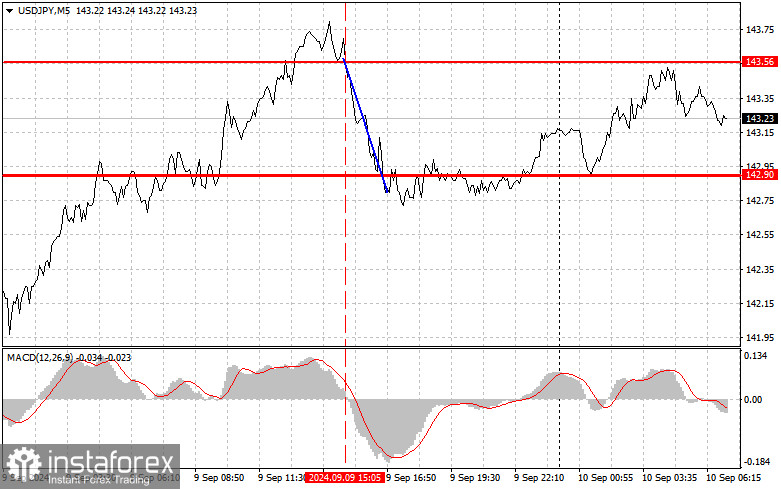Trade Analysis and Tips for Trading the Japanese Yen
The price test at 143.56 occurred when the MACD indicator started moving down from the zero mark, confirming the correct entry point for selling the dollar as part of the downward trend observed in recent months. As a result, the pair dropped more than 60 pips. Purchases on the rebound at the price of 142.90 did not yield the expected result. Yesterday, news about the weak growth in Japan's GDP and a decrease in the volume of bank lending affected the yen's positions, leading to a minor recovery of the pair. However, pressure returned in the latter half of the day, indicating the presence of those wishing to sell the dollar at more suitable and attractive prices. Today's report on the change in the money supply aggregate in Japan kept the pair within the horizontal channel, maintaining chances for its further decline within the medium-term downward trend. As for the intraday strategy, I will rely more on implementing scenarios No. 1 and 2.

Buy Signal
Scenario No. 1: I plan to buy USD/JPY today when it reaches the entry point around 143.45 (green line on the chart) with a target of 144.01 (thicker green line on the chart). At 144.01, I intend to exit long positions and open shorts in the opposite direction (anticipating a move of 30-35 pips in the opposite direction from the level). Today's increase in the pair can be expected as part of a correction. Important! Before buying, ensure that the MACD indicator is above the zero mark and is just beginning its ascent.
Scenario No. 2: I also plan to buy USD/JPY today in case of two consecutive price tests at 143.10 when the MACD indicator is in the oversold area. This will limit the pair's downward potential and lead to a reversal upwards. Expect a rise to the opposite levels of 143.45 and 144.01.
Sell Signal
Scenario No. 1: I plan to sell USD/JPY today only after testing the level of 143.10 (red line on the chart), leading to a rapid decline in the pair. The key target for sellers will be the level of 142.63, where I plan to exit short positions and immediately open longs in the opposite direction (anticipating a move of 20-25 pips in the opposite direction from the level). Pressure on the pair may return anytime, as the bearish market for the dollar has not disappeared. Important! Before selling, ensure that the MACD indicator is below the zero mark and is just starting to decline.
Scenario No. 2: I also plan to sell USD/JPY today in case the price at 143.45 is tested twice consecutively when the MACD indicator is in the overbought area. This will limit the pair's upward potential and lead to a reversal downward. Expect a decrease to the opposite levels of 143.10 and 142.63.

What's on the Chart:
Thin green line: the entry price at which you can buy the trading instrument.
Thick green line: the estimated price at which you can set Take Profit or manually close positions, as further growth above this level is unlikely.
Thin red line: the entry price at which you can sell the trading instrument.
Thick red line: an estimated price at which you can place Take Profit or manually close positions, as further decline below this level is unlikely.
MACD indicator: when entering the market, it is essential to be guided by overbought and oversold zones.
Important: Novice traders in the forex market need to be very careful when making decisions about entering the market. It is best to stay out of the market before important fundamental reports are released to avoid getting caught in sharp price fluctuations. If you decide to trade during news releases, always place stop orders to minimize losses. You must set stop orders to avoid losing your entire deposit, especially if you don't use money management and trade in large volumes.
Remember, a clear trading plan, like the one I've outlined, is essential for successful trading. Making impulsive decisions based on the current market situation is a losing strategy for novice intraday traders.
 English
English 
 Русский
Русский Bahasa Indonesia
Bahasa Indonesia Bahasa Malay
Bahasa Malay ไทย
ไทย Español
Español Deutsch
Deutsch Български
Български Français
Français Tiếng Việt
Tiếng Việt 中文
中文 বাংলা
বাংলা हिन्दी
हिन्दी Čeština
Čeština Українська
Українська Română
Română

